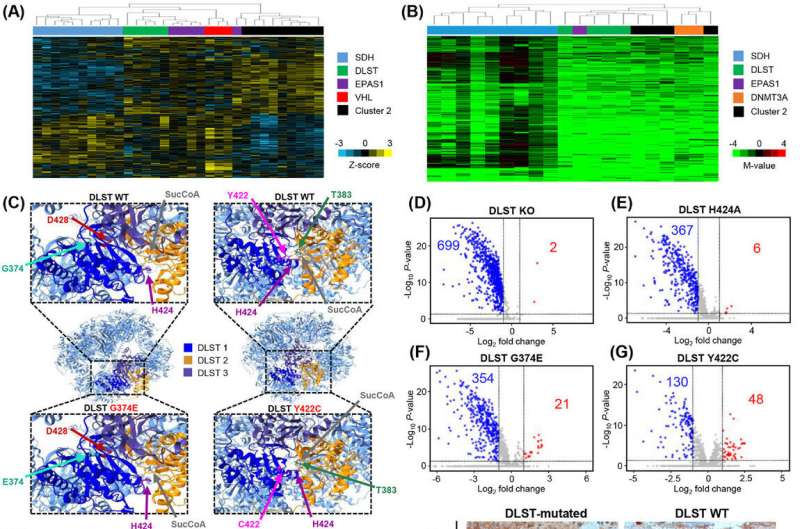This article has been reviewed according to Science X's editorial process and policies. Editors have highlighted the following attributes while ensuring the content's credibility:
fact-checked
trusted source
proofread
Search for origin of rare tumor points to possible hot topic in cancer research: Succinylation

Researchers at the CNIO (Spanish National Cancer Research Center) have discovered that one of the causes for the rare tumor pheochromocytoma-paraganglioma is the interruption of a very specific step in the production of some proteins, called succinylation. This is a relatively poorly studied mechanism that may be involved in more diseases than previously thought, according to the new results, which are published in the journal Cancer Communications.
The researchers find that faults in the DLST protein prevent succinylation, and that DLST is therefore "a promising therapeutic target for treating diseases linked to dysregulated succinylation," they write in the paper.
A mutation causing rare tumor pheochromocytoma-paraganglioma
Proteins are the building blocks of the organism, the structural component of tissues and organs. They are also the nanomachines that carry out all biological functions. There are tens of thousands of different human proteins, and each one has its tasks: transporting oxygen in the blood, contracting muscles, reading DNA and even manufacturing other proteins. When cancer develops, it always implies that there are faulty proteins.
Alberto Cascón and Sara Mellid, from the CNIO Hereditary Endocrine Cancer Group, wanted to understand what was going wrong in five specific patients with pheochromocytoma-paraganglioma. The incidence of these rare tumors, actually considered a single disease, is three to eight cases per million inhabitants each year.
Over the last decade, this CNIO group has discovered five of the 22 genes implicated in the disease so far.
In the case of the five patients whose analysis has led to the new result, the researchers knew the causative mutation, because they discovered it themselves in 2019. But they did not know what was going wrong in the cells because of that mutation.
Malfunctions in cell metabolism, pseudohypoxia and cancer
Proteins are made according to instructions written in the genes; mutations amount to erroneous instructions. The mutations studied by Cascón and Mellid affect the DLST protein, involved in cell metabolism. It is known that when there are faults in some proteins related to cell metabolism, pseudohypoxia can occur, a situation in which tumor cells increase glycolysis as a way of obtaining energy, even in the presence of oxygen, which is to their advantage.
CNIO researchers discovered that the mutated DLST protein effectively generates this cancer-friendly pseudohypoxia by preventing other proteins from being manufactured correctly. Specifically, it prevents other proteins from being succinylated.
Succinylation: Embellishing proteins
Succinylation is one of the last steps in the manufacture of some proteins. Genetic information dictates which pieces make up the protein and in what order they should be arranged; but after the pieces are assembled, like beads on a necklace, they often need to be further completed with specific molecules, which are added like brooches to the necklace. These embellishments change the function of the proteins.
In succinylation, the chemical group succinyl is added to the protein. This mechanism is still poorly studied, "but it seems that it will be very important for protein function and is beginning to be studied extensively, not only in cancer, but also in other diseases," say Cascón and Mellid.
Lack of succinylation leads to cancer
"We see that when the DLST protein has the mutations that we have found in PPGL patients, succinylation does not occur, and that causes many key proteins for cell function to be hyposuccinylated," they explain.
"Proteins not being properly succinylated is what we propose as one of the mechanisms that could give rise to the tumor. Hyposuccinylated proteins in pheochromocytoma and paraganglioma are involved in several processes, and when they do not function correctly, pseudohypoxia is triggered, which favors tumor cells," say Mellid and Cascón.
More information: Sara Mellid et al, DLST mutations in pheochromocytoma and paraganglioma cause proteome hyposuccinylation and metabolic remodeling, Cancer Communications (2023). DOI: 10.1002/cac2.12427

















